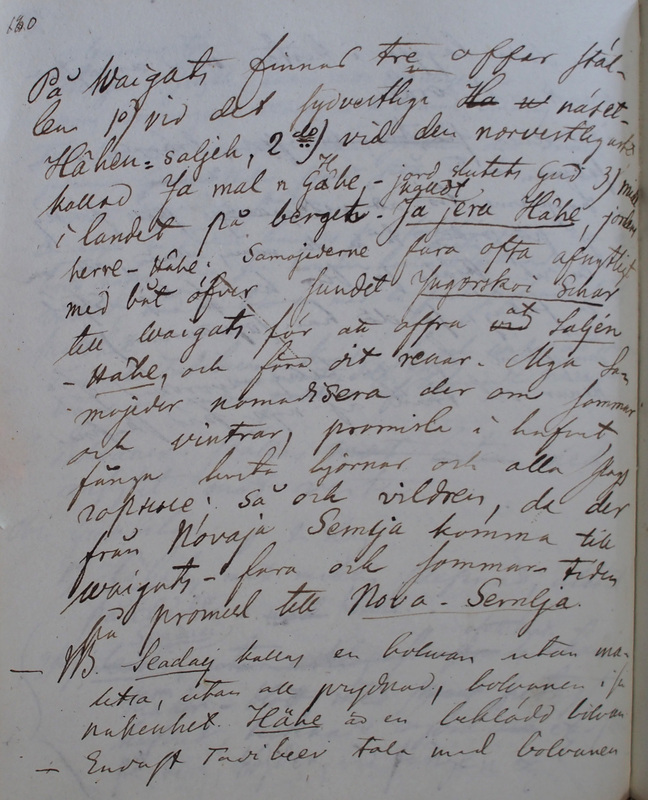Ethnographiska, historiska och statistiska anmärkningar. 180
Title
Ethnographiska, historiska och statistiska anmärkningar. 180
Description
| På Waigats finnas tre offer stäl- len 1) Vid det sydvestliga näset, Hähen=saljeh,
2) Vid den nordvestlig ustjeХэхэʹ саля ʻSacred cape’. The southern cave is situated near TN Вэсако, a seven-headed wooden idol linked to TN Хадако, another idol situated on the northern side of the island. As noted by Archimandrite Veniamin, who led the 1820s missionary campaign, over 400 idols situated near Вэсако were burnt and a cross was placed in the shrine instead. After a few years, the place again abounded in idols and reindeer skulls and antlers. (Veniamin 1855: 122–125; Veniamin 1850: 53; Schrenk 1848: 353–354; Borisov 1907: 89–104)
kallad Ja mal n GHähe
- jord slutets Gud 3) MidtЯʹ малʹ хэхэ ʻEarth’s end idol’. There is no more knowledge available about this place. (Bojarskii 2000: 80–85)
i landet på berget - kallad Ja jeru Hähe,
jordensЯʹ ервʹ хэхэ ʻEarth’s host idol’. This could refer to TN Хадако; see [Bolvanskaja reka].
herre-Hähe. Samojederne fara ofta afnytligt med båt öfver sundet Jugorskoi Schar
The Yugorskij Strait, situated between the mainland and Vaigač. N69°41’41’’ E61°56’31’’. Similar knowledge about the seasonal movement of some Bolʹšezemelʹskaja Nenets between the mainland and Vajgač Island and the obligatory nature of sacrifices when crossing the strait, e.g. in Schrenk 1848: 347–363. See also [Югорский шар].
till Waigats för att offra åt Saljén-Hähe,
och föra dit renar. Mga[Många] Sa-Саляʹ хэхэ ʻCape’s idol’. This refers to the sacrificial complex of TN Вэсако; see [Hähen-salje].
mojeder nomadisera
der om sommarSeveral Nenets families were settled in Novaja Zemlja in the 19th century, when Russia wanted to strengthen its possession of the archipelago. The settlement was based on cooperation between the local Nenets and Russian Pomors: the Nenets would hunt and fish during the autumn, winter, and spring, and trade with the Pomors, who would arrive during the summer months. The traders had their own Nenets partners who would exchange furs for guns, ammunition, textiles, flour, sugar, and tea. They also traded with Norwegian hunters who visited Novaja Zemlja regularly (Lepëchin 1805: 140–152; Serebranny 1997: 304; Shrenk 1848: 362).
och vintrar, promisla i hafvet fånga hvita björnar och alla slags горные; så ock vildren, de der från Novaja Semlja komma till Waigats - fara ock sommar-tiden på promisl till Nova[ja]-Semlja. |
There are three sacrificial places in Waigats: 1) at the south-western point, Hähen=saljeh; 2) at the north-western river mouth called Ja mal Hähe – God of the earth’s end; 3) in the middle of the island on the mountain called Ja jeru Hähe, the earth’s host – Hähe. The Samoyeds often cross the strait of Jugorskoi Schar to Waigats by boat in order to sacrifice to Saljén-Hähe, and to bring reindeer there. Many Samoyeds nomadise there in the summer and winter, hunt in the sea, and catch polar bears and all kinds of mammals; also wild reindeer, which come to Vaigach from Novaja Semlja – they also travel to Novaja Semlja to hunt during the summertime. |
| NB.
Seadaej;
kallas en bolwan utan ma-See [bolvan].
litsa, utan all prydnad, bolwanen i sin nakenhet. Hähe är en beklädd bolvan. |
NB: Seadaej means a bolvan without a malitsa, without any decorations, a bolvan in his nudity. A hähe is a dressed bolvan.
|
| Endast tadibeer tala med bolvanen |
Only tadibes talk to bolvans. |

